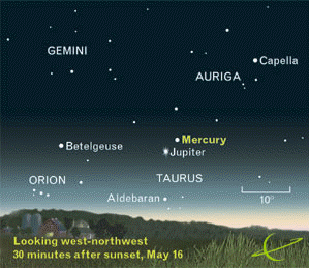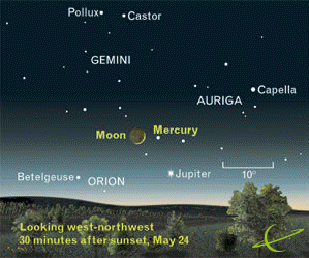HOME
EVENTS
Sighting Mercury
May 2001
Even at the
best of times, Mercury makes only brief appearances in a twilight
sky. Fortunately, the balmy evenings of May 2001 played host to the
finest opportunity of the year to view this normally elusive planet.

 The
problem with observing Mercury stems from the planet's proximity to
the sun. It never lies more than 43 million miles from our star,
while Earth orbits at a distance of some 93 million miles. So from
our vantage point, Mercury never strays far from the blinding glare
of the sun. This means the planet can appear only in the twilight
sky, either in the west shortly after sunset or in the east shortly
before sunrise.
The
problem with observing Mercury stems from the planet's proximity to
the sun. It never lies more than 43 million miles from our star,
while Earth orbits at a distance of some 93 million miles. So from
our vantage point, Mercury never strays far from the blinding glare
of the sun. This means the planet can appear only in the twilight
sky, either in the west shortly after sunset or in the east shortly
before sunrise.
May's
apparition was helped by the steep angle of the ecliptic - the
apparent path of the sun across the sky that the planets also
followed closely - to the western horizon at dusk.
The peak of
the apparition came in mid-May 2001, when Mercury set nearly two
hours after the sun. By then the sky was beginning to grow dark and
Mercury remained at a decent height above the horizon.
The first
object you saw in the western sky was brilliant Jupiter. This
luminary easily ranks as the brightest point of light in the evening
sky and served as a useful guide for finding Mercury. On the evening
of May 14, Mercury lay just to the right of Jupiter.
The two remained close over the next few evenings, with Mercury
moving to Jupiter's upper right.
Resource: Astronomy.com:
Elisabeth Rowan

 The
problem with observing Mercury stems from the planet's proximity to
the sun. It never lies more than 43 million miles from our star,
while Earth orbits at a distance of some 93 million miles. So from
our vantage point, Mercury never strays far from the blinding glare
of the sun. This means the planet can appear only in the twilight
sky, either in the west shortly after sunset or in the east shortly
before sunrise.
The
problem with observing Mercury stems from the planet's proximity to
the sun. It never lies more than 43 million miles from our star,
while Earth orbits at a distance of some 93 million miles. So from
our vantage point, Mercury never strays far from the blinding glare
of the sun. This means the planet can appear only in the twilight
sky, either in the west shortly after sunset or in the east shortly
before sunrise.